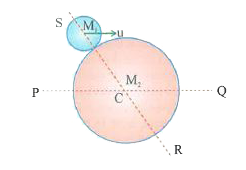An object of mass m moving with speed u collides one dimentionally with another identical object at rest. Find their velocities after collision, if coefficient of restitution of collision is e.
Let v1 and v2 be the final velocities of 1st and 2nd object respectively.
v1=(1−e2)u and v2=(1+e2)u

By law of conservation of momentum μ+m×0=mv1+mv2
⇒v1+v2=u ..................(ii)
Now, e=v2−v1u1−u2⇒v2−v1u=e
⇒v2−v1=eu ............(ii)
Adding Eqs. (i) and (ii)
2v2=u+eu⇒v2=[1+e2]u
Subtracting Eq. (ii) from Eq. (i)
2v1=(1−e)u⇒v1=[1−e2]u
Topper's Solved these Questions
- BOOK - DC PANDEYCHAPTER - CENTRE OF MASSEXERCISE - Check points50videos
CENTRE OF MASS
- BOOK - DC PANDEYCHAPTER - CENTRE OF MASSEXERCISE - Taking it together73videos
CENTRE OF MASS
- BOOK - DC PANDEYCHAPTER - CALORIMETRY AND HEAT TRANSFEREXERCISE - Medical entrance s gallery38videos
CALORIMETRY AND HEAT TRANSFER
- BOOK - DC PANDEYCHAPTER - CENTRE OF MASS, IMPULSE AND MOMENTUMEXERCISE - Comprehension type questions15videos
CENTRE OF MASS, IMPULSE AND MOMENTUM
Similar Questions
A ball of mass m moving with velocity u strikes another identical ball at rest. Find the velocities of the balls after the collision if the coefficient of restitution is e and the collision is head -on. Also , calculate the loss in K.E.
View SolutionA ball of mass m moving with velocity v collides head on elastically with another identical ball moving with velocity - V. After collision
View Solution
Knowledge Check
- Question 1 - Select One
A particle of mass m moving with speed u collides perfectly inelastically with another particle of mass 3 m at rest. Loss of KE of system in the collision is
A34μ2B38μ2C14μ2D18μ2 - Question 2 - Select One
A particle of mass m, collides with another stationary particle of mass M. If the particle m stops just after collision, then the coefficient of restitution for collision is equal to
A1BmMCM−mM+mDmM+m - Question 3 - Select One
An object of mass M1 moving horizontally with speed u collides elastically with another object of mass M2 at rest. Select correct statement.
 AThe momentum of system is conserved only in direction PQBMomentum of M1 is conserved in direction perpendicular to SRCMomentum of M2 will change in direction normal to CRDAll of these
AThe momentum of system is conserved only in direction PQBMomentum of M1 is conserved in direction perpendicular to SRCMomentum of M2 will change in direction normal to CRDAll of these
A block of mass m moving at speed υ collides wilth another block of mass 2 m at rest. The lighter block comes to rest after the collision. Find the coefficient of restitution.
View SolutionA ball of mass 2m moving due east with a speed of 8u collides directly with a ball B of mass m and the velocity of B after collision is 5 u due east. If the coefficient of restitution is 1/11, find the fraction of the total kinetic energy lost?
View SolutionA ball of mass m moving with a speed u1 collides elasticity with another identical ball moving with velocity u2.
(a) Find the velocities of the balls after collision if the impact is direct.
(b) Find the angle between velocities after collision if they collide obliquely and u2=0View SolutionAn object of mass m1 moving with speed v collides with another object of mass m2 at rest and stick to it. Find the impulse imparted to the second object.
View SolutionA particle of mass m moving with speed u collides perfectly inelastically with another particle of mass 2m at rest. Find loss of kinetic energy of system in the collision.
View Solution
